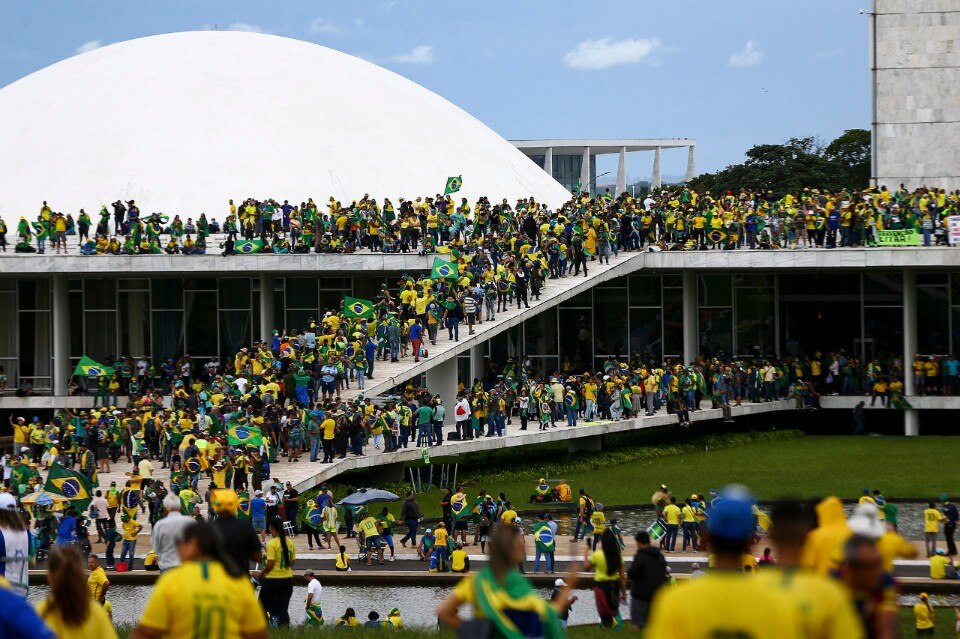The shocking images of the crowds storming the monumental buildings of Brasília wearing the green and gold jersey of the Carioca national team that has become a symbol of the supporters of Brazil’s former president Jair Bolsonaro raise more than one question. The analogy with the January 2021 events in Washington is glaring, albeit with some differences.

In the Capitol, the red-hatted Trumpian mob wanted to physically stop the ratification of the vote, limiting themselves to a few damages to windows and furniture. In Brasília, the Parliament, the Supreme Court and the Presidential Palace were totally empty and filled with modernist furniture and artworks. Therefore, the “vandals,” as President Lula called them, took out their anger on Emiliano Di Cavalcanti’s painting, As mulatas, (1962) puncturing it multiple times, on President Rosa Weber’s chair designed by Polish-born designer Jorge Zalszupin. And more, on the decorative glass panels Araguaia (1977) by French-Brazilian artist Marianne Peretti, stealing the statue Bailarina (1920) by Italian-born sculptor Victor Brecheret, ruining the busts of slavery abolitionists Ruy Barbosa and Joaquim Nabuco, and finally damaging Alfredo Ceschiatti’s statue of Justice in the Praça dos Três Poderes.
In short, the damage is very extensive, and UNESCO, which has an office in Brasília after the city was listed as a World Heritage Site in 1987, has volunteered to quantify all the damage.
We thought the iconoclastic anger belonged to Isis in Syria and Iraq, the Afghan Taliban or the 1966 Maoist Cultural Revolution that claimed the elimination of religious, cultural and ideal “old customs” going so far as to desecrate the tomb of Confucius as well as the remains of the Ming Dynasty.

On the other hand, the Nazis cunningly did not destroy the works of Entartete Kunst, the degenerate “Judeo-Bolshevik” or abstractionist art, reselling them rather to finance their war while the Soviets set up with the best French paintings confiscated from the Schukin and Morozov collections a museum of Western art. In short, one has to go back to the Jacobins and, backwards, to the Calvinist and Puritan reforms in Northern Europe, to the sack of Rome by the Lansquenets in 1527, and to the Byzantine iconoclasm of the 8th century to see works of art and monuments rubbed out or eliminated.
The Louvre storerooms are then full of statues mutilated or decapitated due to “revolutionary vandalism” as Luciano Canfora called it. More recent are the petitions to remove statues of Leopold II in Belgium or the anger of the Black Lives Matter against statues considered remnants of colonialism around the world.

In Odesa, a few days ago, the statue of Tsarina Catherine II – placed down after the 1917 revolution and returned to its place only in 2007– was removed following a referendum. Statues, it seems, are meant to be taken down.
What is not acceptable, on the other hand, is the barbaric destruction of actual works of art: the past cannot be erased although Stalin tried to do so in every possible way with the damnatio memoriae of Trotsky or Bukharin.
The 130 blocks in Brasília have become a refreshing collage of hardcore 60s socialism and neoliberal comfort zones. A unique amalgam of seemingly incompatible elements.
Rem Koolhaas, Brasilia (2011)

Built in less than four years on a project by Lúcio Costa and avowed communist Oscar Niemeyer, the capital city is the result of a social-democratic ordem e progresso + superquadras approach as well as English new towns, but “Brasília is also a city full of ambiguous meanings,” Martino Tattara warns, architect and professor at the University of Leuven.
“The military dictatorship (1964-1985, Ed.) did not hesitate to appropriate it even symbolically, and many leftist sociologists and anthropologists criticized it for the outcomes of its development.” It was after Niemeyer’s death in 2012 that the city was instead extensively reevaluated and historicized, becoming the symbol the anger of pro-Bolsonaro protesters fell against.

Opening image: Palace of Congress, Brasilia, Brazil. Photo Marcelo Camargo/Agência Brasil


